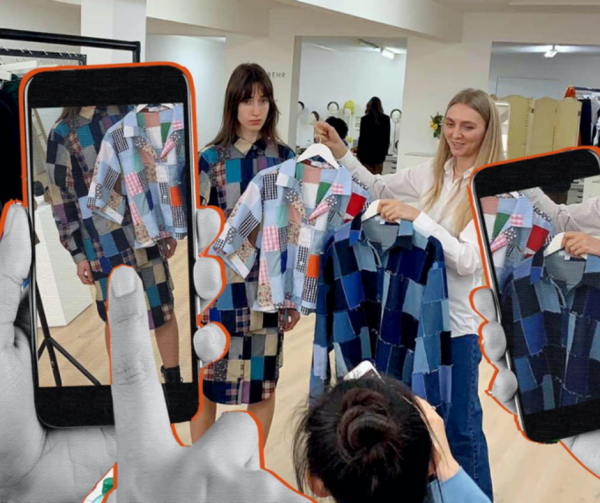Article from David Howell, with comment from Kathryn Wright CSO, Upside Saving
COVID-19 may have changed the retail landscape forever. What will retailing look like in a post-COVID-19 world? Will the high street be able to survive and, how will retailers evolve their strategic use of the omnichannel?
As high streets reopen across the UK, retailing as we know it may have changed forever. COVID commerce will have a massive impact on the relationship consumers have with retailers online and in the high street. The latest figures from the ONS for June, show a bounce-back that has reached almost pre-lockdown levels with sales increasing by nearly 14% compared to May. Looking closer at the figures, however, shows a marked disparity across different market sectors. With face coverings now compulsory in all UK shops and stores, it’s unclear if this will impact high street sales.
It’s clear that digital shopping has seen a huge expansion in the wake of COVID-19. Indeed, according to the Global Shopping Index from Salesforce, the number of new digital shoppers in the US increased by 40% In the UK, retail insights firm Edge by Ascential, says the surge in online shopping caused by the COVID-19 pandemic is expected to add £5.3 billion to UK e-commerce sales this year, reaching a total of £78.9 billion.
Duncan Painter, CEO of Ascential, said: “COVID-19 has greatly accelerated the general shift to digital commerce and it is vital that business leaders have market-leading insights at their fingertips to inform decision-making at this crucial time. It is only through identifying what consumers want and harnessing the entire ecosystem to address these needs that brands can achieve relevance, impact and importantly, growth.”
With Ciaran Bollard, CEO of Kooomo commenting: “Despite the disruption brought to the retail sector by COVID-19, online retail spend continues to increase, with stats showing that by 2024, online retail spend is expected to reach £75 billion in the UK and €3.8 billion in Ireland. But despite this expected growth, it’s important that retailers don’t rest on their laurels and still focus on continuously improving their offering. Those that ensure they focus on the customer experience and adhere to social and environmental duties seek to reap the benefits.”

Developing their retail offering as we enter a post-COVID trading landscape is the central message from Stefan Spendrup, Vice President of Sales Northern and Western Europe at SOTI, who wrote last month: “For some time now, there has been pressure on retailers to not only have technology in place but the right technology. Currently, 76% of consumers want personalised in-store experiences from mobile devices, and self-checkout devices are perceived to not only be beneficial to the shopping experience (40%), but necessary to improve the shopping experience (47.%).
“The research also indicated that shoppers would be happy with at least one or more delivery options outside of traditional in-store transactions. Shoppers are moving away from cash transactions to chip and pin, or contactless payments. This positive trajectory towards digital adoption and trust is a sure sign of retail’s initial mobile transformation.
“In the UK, there is optimism for technology and its role in improving the retail arena, even if they would like these new solutions to complement more traditional systems rather than completely overhaul them. Retailers need to tune in to customer preferences in the same way Glossier has demonstrated,” Spendrup concluded.
‘New normal’ retailing
There is little doubt that retailing will change in the aftermath of the COVID-19 pandemic. The high street will be reshaped and online, expansion of services will rapidly evolve to meet the needs of a consumer base that will increasingly switch a large percentage of their purchases to digital stores. Kantar’s COVID-19 Barometer makes a stark prediction that as many countries relax lockdown laws, and commercial businesses reopen, across the world 66% of people say they will continue to avoid busy places, meaning a drag on physical retail environments.
And according to Bloomreach: “Customers will pay for a better experience, but businesses struggle to provide essential must-haves. Customers say they prefer online channels for researching, buying, and finding inspiration. Nearly 40% of consumers and 56% of B2B customers say they would pay more for a better experience, and they will not buy from the same business again if they have a bad experience. Yet too many businesses don’t provide basic capabilities like easy website navigation, relevant search results, or clear product information. Almost 80% of customers abandon their purchases because of these reasons, jumping to competitors that better meet their needs.”
It has been somewhat of a given that all retailers have a well-developed online strategy they can leverage to help them pull through the pandemic crisis. The findings from Gareth Hoyle Digital Due Intelligence paints a very different picture concluding 54% of the 1,000 UK senior decision-makers and business leaders have little to no understanding of how their online operations work. In comparison, 32% admit they are not familiar with online marketing techniques.
“It’s important to remember for businesses, that there is more to running an online business than digital marketing,” said Gareth Hoyle, founder and managing director of Gareth Hoyle Digital Due Diligence. “A complete understanding of online operations is needed before decisions are made about marketing. This clarity allows for better decision making about digital marketing otherwise investment decisions can be thrown down the drain.”
Turning to the B2B space, a shift in activity can be clearly detected: The B2B Future Shopper report, 2020 concludes: B2B online purchases have increased by nearly a quarter (24%) since last year. With COVID-19 driving more consumers online, the number of online B2B purchases has risen from 41% before lockdown to 46% during lockdown. And changes in consumer behaviour have already forced some businesses to switch suppliers to facilitate their new ways of working, with nearly a fifth (18%) of buyers changing supplier for all purchases as a result of the pandemic.
Neil Stewart, CEO, Wunderman Thompson Commerce said: “We’ve seen COVID-19 dramatically shake up consumer retail, so it is unsurprising to see a similar pattern in the B2B landscape. However, with supply chains heavily impacted by the pandemic, businesses are struggling to match this demand and need to have the infrastructure in place to cope with surging online sales. Many buyers may not be comfortable, or even able, to purchase items in person and will, therefore, look to the plethora of other options available online. The number one priority for B2B retailers over the coming months will be to ensure they can provide the same services online as they do via physical channels.
“Amazon’s popularity as a B2C platform means it is poised to tap into the growing demand for e-commerce in B2B. Nearly a fifth (18%) of all B2B buyers start their journey on Amazon Business, with 11% starting on its B2C site. Almost three-in-five (59%) don’t currently purchase through Amazon Business, but say they intend to in the next 12 months. Whether it’s Amazon or another online marketplace, almost three-quarters (74%) express a want for something akin to Amazon Business, claiming it’s more convenient than purchasing through individual supplier portals; this figure rises to 87% for medium-sized business, 84% for the biggest companies and slightly over two-thirds (68%) of SMEs agree.”
Post-COVID trading
It’s no surprise that online commerce has seen massive expansion since the lockdown in April. According to the research from Forrester, nearly half of decision-makers whose businesses sell online (46%) report growth as a result of COVID-19. This growth is a direct consequence of increased online activity like the volume of search, traffic, and orders. Compared to pre-COVID-19 plans, investment in offline channels (e.g., retail stores, in-person sales) has been cut in half while most businesses plan to increase their investment in online channels like direct web, apps, social, and third-party marketplaces.
Tony Preedy, chief commercial officer at Fruugo says: “Online marketplaces have played a huge role in helping retailers maintain sales throughout the COVID-19 crisis, and we see their place in the eCommerce landscape only solidifying over time. To efficiently manage online sales, retailers need to become efficient data wranglers, and if they do not have the right level of competency internally then the expertise that third parties such as marketplaces can offer is key. With millions of data points relating to hundreds of different retailers, marketing can be optimised and adapted for various regions automatically.”
The omnichannel, as we know, will continue to evolve. This is the message from Christopher Baird, the Senior Manager at Capgemini Invent, who explained to Silicon UK: “We had already started to see retailers play around with their physical store models pre-COVID, but the current situation has only acted as a catalyst for change in this space. I expect that we’ll see some more blurring of lines between the online experience and in-store experience.

“Online retailers will want to try and take some of the pressure away from their supply chain, and one way that technology can help with this is to try and reduce the amount of returned orders being processed. Some retailers have started testing out AI to recommend the best size of clothes based on previous purchases and returns, and others – like ASOS – have taken this a step further to try to use Augmented Reality to create ‘virtual catwalks’ for customers, so that they can see how clothes might look on them without the need to go into a physical changing room.”
Baird concluded: “On the flip side, retailers will need to make better use of data in their physical stores to not only understand the changes in shopping behaviour through analytics but to better engage with the customers that do come into the store so that they have a more personalised experience. Most retailers aren’t yet in a position to offer this type of individual service in-store, but ‘clientelling’ solutions are being improved by better use of data and will be able to enable this in the future.”
Brad Soo, Product Manager at commercetools, said: “We’ve talked a lot on how the only certainty in retail is uncertainty. This cannot hold truer in a post-pandemic landscape. In the short-term future, some markets will see a spike in purchases (e.g., home appliances) while others will drop (e.g., certain clothing). A setback in the global economy may also trigger a reduction in consumer spending until employment rates and the financial market improve. However, we’re positive regarding the longer term when we might see a ‘new normal’ in retail customer behaviour and spending that weighs online shopping more heavily.”
With Kathryn Wright, CSO, Upside also commenting: “The real challenge for retailers will be Christmas 2020. It’s well known that retailers make a large share of their annual sales over the holiday season: anywhere between 20% and 30%. Given that we have had two / three months of significant sales losses (April, May and June largely), retailers will be in a rush to push to make up annual targets. Retailers normally try and achieve this through deep discounting, but this could worsen the problem, pushing net sales totals down even further: lower demand, and lower ticket prices. We know that there is a season’s worth of stock that needs to be sold, even if at a loss, because warehousing space is so expensive too. This puts even more pressure on sales for the last two quarters of 2020.”